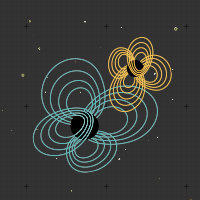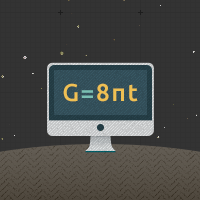E
E
Einstein's Equations
A set of "tensor" equations Einstein devised to describe how mass warps spacetime. The set of equations may be written as \(G = 8 π T\), where both \(G\) and \(T\) each represent a set of ten quantities. The \(G\) quantities represent the warping of spacetime, while the \(T\) quantities — the "Stress-Energy tensor" represent the mass.
Electromagnetic Wave
An electric and magnetic disturbance that travels through space like a wave. What we experience as light is an electromagnetic wave. Electromagnetic waves therefore travel at the Speed of Light. Other types of electromagnetic wave range from Radio Waves and Microwaves, through to X-Rays and Gamma Rays.
Electron
A tiny particle usually found swirling around an atomic nucleus, the electron carries the standard unit of negative charge, which balances the positive charges in a nucleus. The interaction between electrons and nuclei is responsible for chemistry. Electrons can become detached from the nucleus, when given enough energy, and become free. Electrons are members of the particle class called fermions, and are roughly 2,000 times lighter than neutrons and protons.
Elementary Particle
A particle which is not made up of smaller particles. The neutron and proton are both made up of smaller particles — called quarks. On the other hand, quarks are not believed to be made of anything smaller. Like quarks, electrons and photons are also believed to be elementary particles.
EMRI
Extreme Mass-Ratio Inspiral — A particular type of binary in which there is a very large difference in the masses of the two objects. Generally, this will involve a super-massive Black Hole with a mass millions of times that of our Sun, and a Neutron Star or Black Hole with a mass roughly the same as our Sun.
Epicycle
A secondary circle centered on another, usually larger, circle. Its center moves along the circumference of the main circle.
Event Horizon
A surface — like the one surrounding a Black Hole — enclosing a region of space from which nothing (even light) can ever escape.
Exclusion Principle
A rule in Physics which says that no two identical particles can be in the same state (position, for instance) at the same time. This principle only applies to fermions, not to bosons. It is usually referred to as the "Pauli Exclusion Principle", after its inventor Wolfgang Pauli.
Extreme Mass-Ratio Inspiral
A particular type of binary in which there is a very large difference in the masses of the two objects. Generally, this will involve a super-massive Black Hole with a mass millions of times that of our Sun, and a Neutron Star or Black Hole with a mass roughly the same as our Sun.




